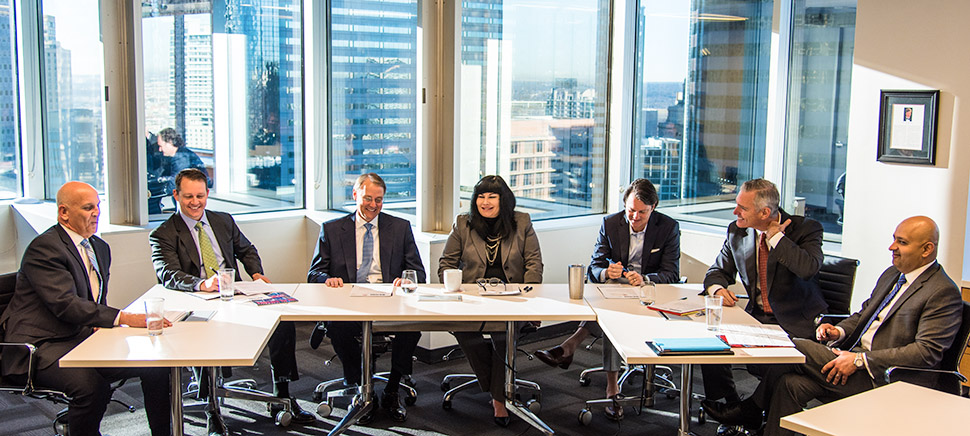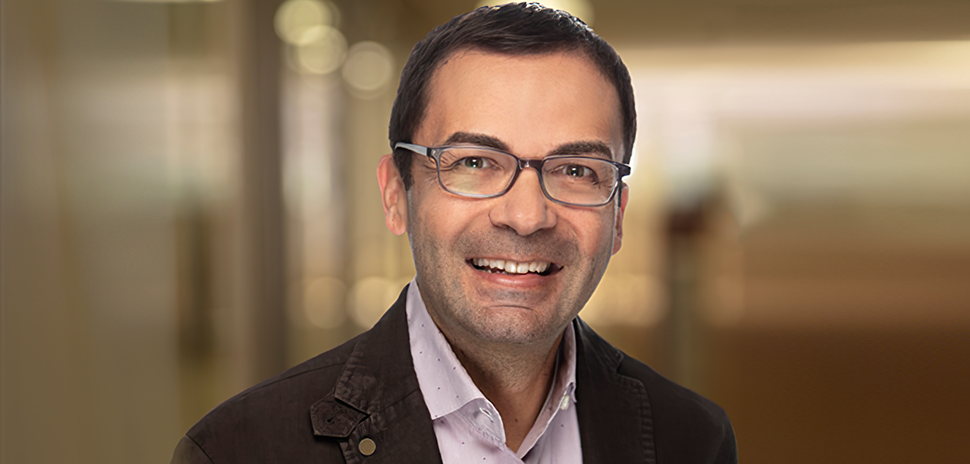This article originally appeared in the Dallas-Fort Worth Real Estate Review, Spring 2016.
PART THREE OF A THREE-PART SERIES. READ PART I AND PART II. PANEL MODERATED BY CHRISTINE PEREZ.
THE PANELISTS:
BRYAN MARSH As vice president, Bryan Marsh serves as Digital Realty’s Central region portfolio manager. He has overall responsibility for strategic planning, acquisitions, development, operations, leasing, and financial performance of 43 buildings with 4.7 million rentable square feet.
BRYAN LOEWEN Bryan Loewen leads Newmark Grubb Knight Frank’s global data center practice. He works closely with the company’s 300 worldwide offices to help companies develop business continuity plans and mission-critical strategies involving data centers, colocation sites, and hosting facilities.
BILL BURTON As executive vice president of Hillwood Properties and Hillwood Urban, Bill Burton has been a key player in the transformation of AllianceTexas from raw ranch land to an 18,000-acre, masterplanned development. He also was instrumental in bringing a Facebook data center to Fort Worth.
CAROLINE BRELSFORD Caroline Brelsford is central regional director for CyrusOne, which specializes in reliable enterprise data center colocation. A seasoned industry executive, she has helped the world’s leading brands reduce risks and costs associated with critical data center infrastructure.
BO BOND Bo Bond is managing director and co-leader of JLL’s global data center solutions practice team. A recognized industry leader with more than 24 years of experience, he has successfully negotiated more than 20 million square feet of real estate transactions in multiple states.
BRANT BERNET As senior vice president in CBRE’s brokerage services group, Brant Bernet leads the firm’s data center team. He previously was a principal at Trammell Crow Co., where he helped pioneer high-tech tenant representation. He went on to launch Rackhouse Group, which focused on data center site selection.
ANDY ABBAS Andy Abbas, co-founder and vice president of Data Agility Group, which specializes in data and data center migrations, data center relocations and consolidations, and related services. He has been in the industry for more than 30 years, holding IT executive posts at AT&T and Sears.
Dallas-Fort Worth has quietly become the nation’s No. 2 data center market. To get an update on activity in the region, we gathered some of the top minds in the business for a panel discussion. Here’s what they had to say:
We talked a little bit about supply and demand, with supply becoming more constrained. How are developers responding to that? What do you expect to see in terms of new development this year?
BRELSFORD: Build, baby, build. You’ll see that with all of us, don’t you think?
“Build, baby, build.” – Caroline Brelsford
BOND: Absolutely.
LOEWEN: We tracked at about 650,000 feet of either under construction or potential construction first-phase-type stuff for 2016 and 2017. The market has listened to the fact that demand is high and supply is — like I said, there are some sold-out signs, and you never see that in the data center business.
BURTON: We’ve developed some data centers in the past. It’s really not our core. We build a lot of other product. For us, it’s really looking at the land, and then how do we access all of this infrastructure? How do we maintain the pathways? How do we make sure we can provide an environment that the users will want? And so as we do our land planning and develop around, for example, the Alliance area, we look closely at maintaining and protecting the purest environment we can to provide the flexibility, the speed to market. We also spend a lot of time with our local governments, because we’re in four different cities. When data center operations come in, time is money, and it’s very important to have those good relationships and have them understand what’s driving their business. And so we spend a lot of time with them trying to help educate them on that topic as well.
LOEWEN: Brant mentioned the supply that’s going on, and there’s been a lot of supply that’s been coming into the Dallas-Fort Worth market lately. Users have historically wanted to see it before they buy it. And that inventory is not sitting in place, for the most part, in Dallas-Fort Worth right now. It’s still a little bit to-be-determined as to what 2016 and 2017 are going to look like, because that inventory is not there, where it has been in the past. It’s been absorbed pretty quickly.
“Of the ‘Big Six’ publicly traded data center developers, four of them are here in Dallas, and all four are theoretically swinging hammers or have permits and sitting.” – Bo Bond
BOND: Of the “Big Six” publicly traded data center developers, four of them are here in Dallas, and all four are theoretically swinging hammers or have permits and sitting. So they’re building. But it takes a lot longer with the mechanical and electrical infrastructure that we’ve put into these buildings to be able to bring them to market versus your standard four slab walls. The folks who are in the room have streamlined and do things at lightning speed, but that’s because of the brilliance they have behind their construction teams, their supply chain and working with very smart people who have come up with great designs, and their suppliers being out in front of them.
MARSH: We have broken ground on a 300,000-square-foot building in Richardson that will be delivered in November. It will start off with 6 megawatts, but will easily grow up to as much as 36 megawatts. We’ve got the scalability and flexibility to meet the market, as the customer demands are there. A year or so ago, we moved to an adjusted time delivery where we wouldn’t have inventory just sitting finished and vacant. Once we got the shell up, we could deliver it, really, in four or five months. We like going that route where we can have pre-leasing in place to eliminate some of that risk and that downtime. But in Dallas, you need to have a little bit of space sitting there ready where someone can move in because a lot of times these requirements pop up and they need it tomorrow. It’s good to have a little bit available.
When a headquarters moves here or a company sets up a big regional operations center here, does the data center usually come along at some point?
LOEWEN: All across the board, I’d say, yes. State Farm did that, as an example, but it doesn’t always happen. A lot of times that data center piece is a very difficult thing to migrate, and it might lag. Ideally, I think it would be in the same market as that headquarters, but it doesn’t happen all the time.
BERNET: It just depends on the makeup of that particular company. Some will say, yes, we’ve got to have it right here because I want to go see the blinking lights and make sure that we’re able to touch it and change out the C Drive or whatever we need to do.
“If you go look at the stack of the bigger [relocation] announcements, I would say more than half of those have moved some form of data center component here.” – Bo Bond
BOND: If you go look at the stack of the bigger [relocation] announcements, I would say more than half of those have moved some form of data center component here. We’re using more data centers, but we have production data centers, we have research and development, business continuity, disaster recovery. Some form of that truly, I believe, ends up in the city.
ABBAS: Organizations historically have wanted their data centers close by, but that’s becoming less and less of a concern. As Bo mentioned, they may like to have some component of their data centers local, but then because their connectivity is so much in abundance, they can have a lot of their [disaster recovery], as well as their — in particular the DR they wouldn’t want in the same location, anyway, but R&D involvement can be at other facilities. I agree with what Brant said, that it’s really been a good half-and-half approach, where a lot of organizations have decided to move, and others have said we’re going to keep them where they’re at.
LOEWEN: Subjectivity comes into play. Having proximity to the headquarters is definitely an advantage. In a market like Dallas where the rates are competitive, it weighs in our favor when there’s a larger regional headquarters presence there.
What about House Bill 1223, the data center sales and use tax break that passed in 2013? Has that helped?
MARSH: I think that’s why Facebook is here.
BOND: I call it elephant hunting because it’s done a great job attracting some very large users here, but I think the state of Texas is missing out on the majority of the market — the smaller users. We’ve been trying for the last couple of sessions to tweak the bill a little bit so it can apply to more customers looking to come into Texas. It has gotten very competitive, and we’re competing with states all around the country.
BOND: In 2013, when HB-1223 was passed, I think, for us, that it started the conversation. In 2015, there was legislation passed, and it actually was larger than 1223. That’s what helped Facebook get here. Stuff that didn’t get passed that a lot of people in the room spent a lot of time working on is where we need to be, where it allows the user to truly benefit coming in and reside still in the masterful hands of a colocation data center operator, whether that benefit starts and inures to the benefit of the two — the tenant, or it can just go directly to the tenant. I hope we as a community can band with other different communities and get down to the state during the next session and see that. We’ve seen projects that would have landed in the state of Texas, probably in the city of Dallas, that went to other markets just because there were absolutely more aggressive state programs in other major metropolitan areas.
What about opportunities for southern Dallas and infrastructure there? Are there things in place in southern Dallas County that could support data center operations?
BOND: You used the word “infrastructure.” If you were to look at the greater DFW area and, to Bill’s point earlier — what Alliance brings in this area — it’s the infrastructure. So the abundance of power, the abundance of fiber. Fiber is much more rich in the northern community than in the southern community, just based on what’s been put in the ground. You also have a higher potential or perceived risk potentially in the southern sector — little more flood, little more rail.
“What southern Dallas has going for it is its proximity to the big carrier hotels in Dallas, which are 2323 Bryan Street and the Infomart.” – Bryan Marsh
MARSH: What southern Dallas has going for it is its proximity to the big carrier hotels in Dallas, which are 2323 Bryan Street and the Infomart. When you talk about low latency, the closer you can be to those hubs, the better off you’re going to be. There is an abundance of land sitting just across Interstate 30 that’s close to those facilities downtown. If you could get the infrastructure in place and some of the other things, there could be real opportunity connecting back to those gateways.
BURTON: When we say infrastructure, it’s not enough to have access to it, it’s the redundancy that goes along with that.
Let’s get everyone’s outlook for 2016, the challenges and opportunities.
ABBAS: The opportunities are great because there is a lot of activity happening. A lot of companies are realizing they want to move into either a sale/lease-back or move to a colocation facility. There are still a lot of companies wanting to relocate here for all the reasons that we discussed. There’s a lot of change. And for our business, that’s perfect.
BERNET: The future is bright. It’s a great time to be in the data center business on all sides, be it land or colocation or real estate or brokerage side. For Dallas, 2016 will have some challenges, because of the lack of space that’s available. But 2017, 2018 …we just look into the future. The requirements that started the need for data centers years ago haven’t changed, except that they have just continued to grow.
BOND: To echo a little of what Brant said, the interim challenge is maybe a lack of supply, but that will take care of itself just by folks that are on the ground today developing. The upside is here. That will be delivered. I think our economy is healthy. As long as we don’t run into a significant global issue, then I think we’re still going to have a bright, bright future here for years to come.
BRELSFORD: I share the same outlook as these gentlemen here. We’ll also continue to see a number of enterprises that are out of state come visit this wonderful city and see what we know to be true in terms of the economic conditions here. We’ll continue to play host to visiting entities looking to—maybe—put roots down here. So it’s a very, very exciting time.
BURTON: As I look at the broader economy, I have some concerns because of the geopolitical situation, as well as things taking place domestically. But with the increased users and user engagement, I think the opportunity in this particular sector is outstanding. We have the cost structure, we’ve got the access, everything that we talked about. This business is going to continue to grow, and I think that looks very well for DFW.
LOEWEN: I think in 2016 and 2017, we’ll see a lot more consolidation in M&A activity in this overall industry. There’ll be fewer companies, but they’ll be larger in size. With the M&A activity and company portfolios that are for sale, we’ll find that there will be consolidation in the overall industry. Dallas-Fort Worth will be one of the markets where you will see a handful of companies picked off.
MARSH: I think the challenge for Dallas is to develop in a smart manner. We have a history on the real estate side of sometimes overbuilding and getting overly excited because we have a lot of great developers in the city and it’s a great real estate community. So I hope that the data center [developers] will learn from some of the mistakes that were made in the past in some of those other areas, and be prudent with development so we can keep the supply and demand in check, and keep our rents at levels where we can make money and generate good returns for our shareholders.
READ PART I AND PART II.
For a daily dose of what’s new and next in Dallas-Fort Worth innovation, subscribe to our Dallas Innovates e-newsletter.

Panelists Bryan Marsh, Bryan Loewen, Bill Burton, Caroline Brelsford, Bo Bond, Brant Bernet, and Andy Abbbas. (Staff photo by Michael Samples)





































































